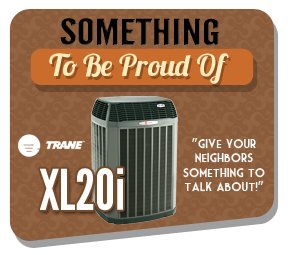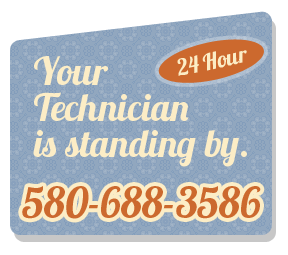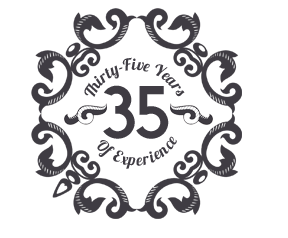F.A.Q.'s (Frequently Asked Questions):
How Air Conditioning Works
WHAT IS IT?
The most common central cooling system is a split system, which includes an outdoor cabinet containing a condenser coil and compressor, and an indoor evaporator coil, usually installed in conjunction with your furnace or air handler. The compressor pumps a chemical called refrigerant through the system.
HOW DOES IT WORK?
The warm air inside your home blows across the indoor evaporator coil and the heat energy from the air transfers to the refrigerant inside the coil. Think of the refrigerant like a sponge, absorbing the heat from the air. As a result, the air is now “cool”. The cooler air is circulated back through the home providing comfort. The refrigerant is pumped back to the compressor where the heat absorbed by the refrigerant is released and cycle begins again. Moisture that contributes to humidity is also condensed out of the air.
Your cooling system is usually combined with your central heating system because they share the same ductwork for distributing conditioned air throughout your home.
FACTS:
- The typical central air conditioning system is a split system, with an outdoor air conditioning, or "compressor bearing unit" and an indoor coil, which is usually installed on top of the furnace in the home.
- Using electricity as its power source, the compressor pumps refrigerant through the system to gather heat and moisture from indoors and remove it from the home.
- Heat and moisture are removed from the home when warm air from inside the home is blown over the cooled indoor coil. The heat in the air transfers to the coil, thereby "cooling" the air.
- The heat that has transferred to the coil is then "pumped" to the exterior of the home, while the cooled air is pumped back inside, helping to maintain a comfortable indoor temperature.
- Central air conditioning can also be provided through a package unit or a heat pump.
How Central Heating Works
WHAT IS IT?
Central heating systems have a primary heating appliance, such as a furnace, typically located in your basement or attic. All furnaces consist of four main components: 1) burners that deliver and burn fuel, 2) heat exchangers, 3) a blower and 4) a flue that acts as an exhaust for gaseous by-products. Depending on your situation, region and needs, you can choose from heating systems running on either gas or oil as fuel, or a hybrid packaged system that can use both fuel types.
HOW DOES IT WORK?
Combustion gases are generated by the burners in your furnace and passed over a heat exchanger. Air from your home blows across the heat exchanger to be warmed. It is then blown through a system of ducts to distribute around your home.
During warm seasons your heating system works with your central air conditioning. Air is cooled as it’s blown over your air conditioning unit’s cooling coil, often attached to the exhaust of the furnace, and then sent over the same air ducts throughout your home. An independent American Standard dealer can help you decide which central cooling and heating system is right for you. American Standard matched systems can be customized with cooling and heating units that match your situation and let you choose from a range of energy efficiency.
FACTS:
- Heat pumps are used for either the heating or cooling of your home by transferring heat between the indoors and the outdoors. Because heat pump systems transfer heat rather than generating it, they are more energy efficient.
- In the warmer months, the heat pump acts like an air conditioner, removing heat from the air inside your home and transferring it outside.
- During colder months, the opposite is true, as the heat from outdoor air is extracted and transferred to the interior of your home. Believe it or not, even a 32 degree Fahrenheit day produces enough heat to warm a home using a heat pump.
- A typical heat pump consists of an outdoor unit similar to a central air conditioning system and an indoor unit called an air handler. A compressor pumps refrigerant (also known as freon, R22 or R410A) that absorbs and releases heat as it travels between the indoor and outdoor units.
- Heat pumps are best for moderate climates, keeping homes warm even when temperatures drop into the low 20s. A supplemental heating source may be needed for lower temperatures.
Selecting a Reputable Contractor
INSURANCE AND LIABILITY
When considering a HVAC contractor, ask to see documentation that they carry general liability insurance to protect your property as well as workers compensation insurance on their employees. The State of TX does not require employers to carry workers compensation insurance. Lack of adequate insurance could be a major problem for you if someone is injured on your property. An air conditioning contractor should always have these types of insurance and this will save you from a claim against your homeowner’s policy in case of an accident.
CHECK LICENSE
Choosing a HVAC contractor should include checking with the TDLR. Be sure that the HVAC contractor’s license is current and check if the TDLR has a history of disciplinary actions or complaints published on their website at http://www.license.state.tx.us. Another source for finding a competent HVAC contractor is the local permits office for your municipality. The municipal inspectors know the HVAC contractors who do good work from the HVAC contractors who do poor work.
STANDARD PROCEDURES
Once you identify and contact several HVAC contractors set up an appointment with each of them to visit your home. You should not be charged for this initial appointment. During the meeting the contractor should inspect your existing air conditioner and collect a wide range of information about your home, how many windows and type, which direction they face, and R-value of the insulation. The contractor uses all of this information to calculate the heat load to verify that the existing equipment is correctly sized and proposed equipment is also correctly sized. You should receive a written estimate from each contractor. If one contractor submits a bid that is dramatically different from the other bids ask the contractor to explain the difference. Some HVAC contractors represent only one line equipment and using these contractors has advantages and disadvantages. On the plus side the contractor has probably gone through specialized training offered by the manufacturer. Should there be any problems with equipment performance you may have additional leverage because you may be able to involve the manufacturer. If you get estimates from contractors that sell other brands make sure they are recommending equivalent equipment.
Should I Repair? or Replace?
This is always a difficult a decision. On one hand you don't want to spend money on a new system, but on the other hand, you don't want to throw good money after bad. Which way should you go? It really boils down to the condition and age of the air conditioning system.
If you have been keeping your equipment properly maintained by a licensed air conditioning technician, then perhaps the current repair is isolated to a single, simple problem and not indicative of a major or potentially recurring issue. In this case it might make sense to repair and fix the problem. However, with any equipment it is important to consider its efficiency and the impact that wear and tear has on that efficiency and on your monthly electric bill.
Importance of Efficiency
The Seasonal Energy Efficiency Ratio (SEER) rates the efficiency of an air conditioning unit. A unit somewhere around 10 years old would probably have been an 8 SEER unit at time of purchase. Over time this unit will wear down and operate somewhere around the 5-6 SEER level. The higher the SEER rating, the higher the efficiency of the unit. In 2006 the minimum SEER rating for an Air Conditioning unit was raised to 13 SEER. Upgrading to a newer Air Conditioning unit is surprisingly affordable based on the efficiency level of modern equipment. The money saved on your electric bill from upgrading will pay for the unit itself. So transitioning from an 8 SEER unit to a new 18 SEER unit will allow better performance at your current budget.
It All Adds Up
When your A/C unit starts giving you trouble, the A/C Technician is usually your first call. But when you begin calling them day after day the bills add up and you are left with the same outdated inefficient unit. A new unit produces cooler air, with less energy. Less energy means a lower utility bill. Which means you could be paying for a new unit, rather than life support for your old one.
Doing Your Part In Going Green
Using a higher SEER unit saves energy. Saving energy saves the environment. Using technologies such as the eco friendly R410A refrigerant will also minimize the overall environmental impact. Therefore, you can feel good about saving both the planet and money on your energy bill with your new air conditioner.
Energy Saving Tips
- Maintain Your System - You can ensure your system operates at peak performance by scheduling semi-annual maintenance checks.
- Zoning - A zoning system can drastically lower your heating and cooling costs. With zoning, you no longer have to pay to heat or cool areas of your home that are rarely used.
- Programmable Thermostats - According to the Department of Energy, a programmable thermostat can reduce your heating costs by up to 35% and cooling costs by up to 25%.
- Close curtains on south- and west-facing windows during the day
- Plant tall, fast growth trees on the south side of your house
- Install white window shades, drapes, or blinds to reflect heat away from the house
- Plug air leaks with caulking, sealing, or weather stripping to save 10 percent or more on your energy bill
- Replace standard incandescent light bulbs with compact fluorescent light bulbs (CFLs)
- Unplug electronics, battery chargers and other equipment when not in use. Taken together, these small items can use as much power as your refrigerator.
- Reduce air conditioning costs by using fans, keeping windows and doors shut and closing shades during the day.
- When possible, wash clothes in cold water. About 90% of the energy use in a clothes washer goes to water heating.
- Run your dishwasher and clothes washer only when fully loaded. It takes the same amount of energy to run a full load as it does a partial load.
- If your home sits empty a good part of each day, consider investing in a programmable thermostat or manually adjust the temperature each time you leave and return home.
- Never put lamps, TV sets and other heat-generating gadget beneath a wall-mounted thermostat.
- Close Fireplace Dampers.
- If you use standard filters, change them monthly. If you use an electrostatic filter, rinse it out regularly
- If you have a mechanical air filter or HEPA filter inside your heating and cooling system, have an air conditioning and heating technician replace the filter annually.
- Allow air to circulate around your outside condenser unit. Fallen leaves may hinder the efficiency of the air conditioning unit so make it a habit to clear your air conditioning units with fallen shrubs. This means pruning any nearby hedges and keeping the grass mowed. Treat the area for fire ants, as needed. Ants commonly build mounds inside condensers and can cause your air conditioning to shut down.
- Have Your Air Conditioner Inspected Each Spring. An annual inspection of your cooling system may extend the life of your equipment and save you money by lowering your energy bills. Poorly maintained air conditioners can waste a tremendous amount of energy. "National statistics show that over 70% of all air conditioning and compressor outages could be avoided if the equipment was regularly checked, adjusted, calibrated, and maintained by qualified technicians." (Source - Around the Clock: Energy Saving Tips)
Should I Finance?
Monthly finance charges never sound like a good thing. What if there was a way to stick with your current budget and have a brand new A/C Unit? Well using a higher SEER unit this is a very real possibility. The amount of savings generated from your lower monthly electric bill could very well take care of any finance charge. Imagine - a cooler house, with a better unit, at your current budget.









